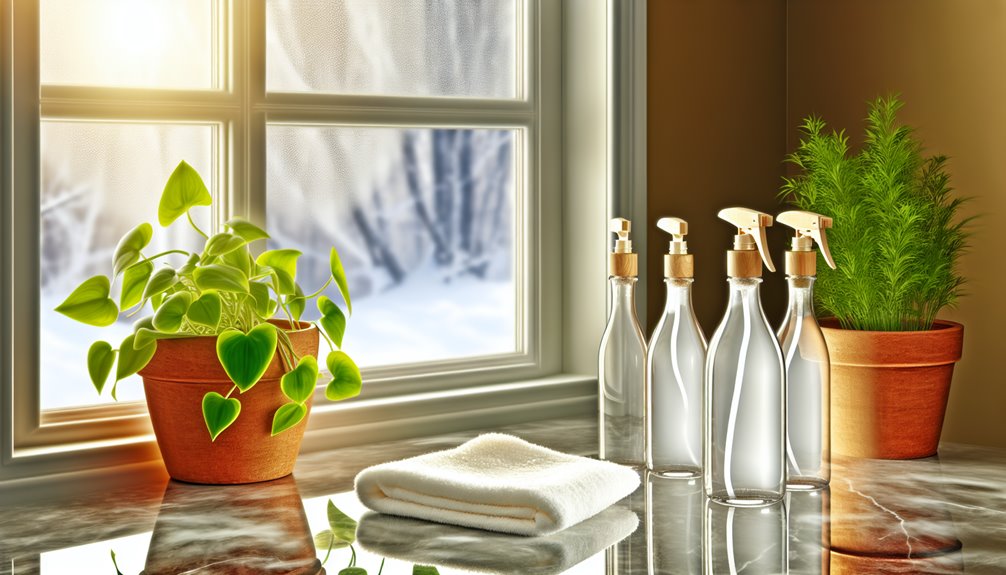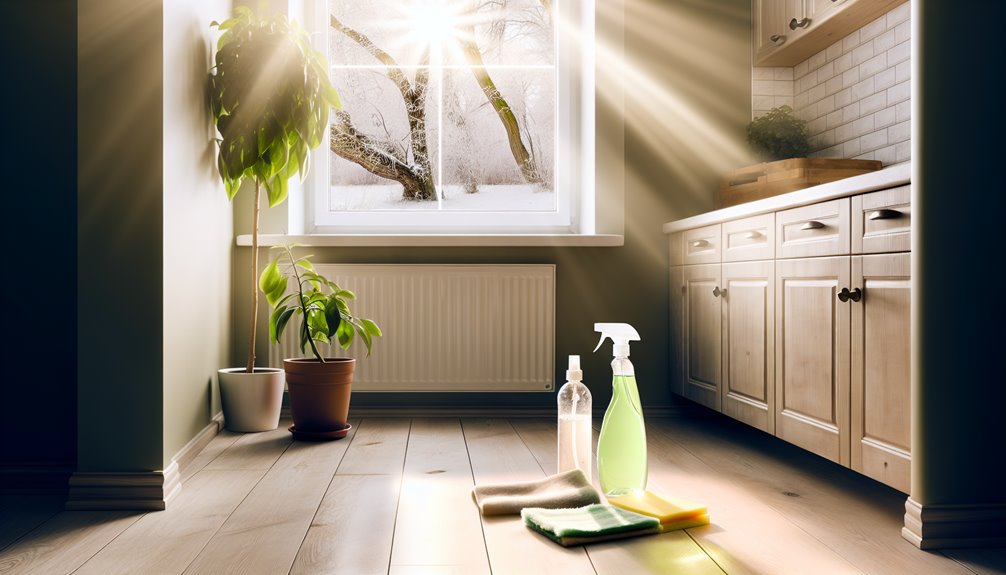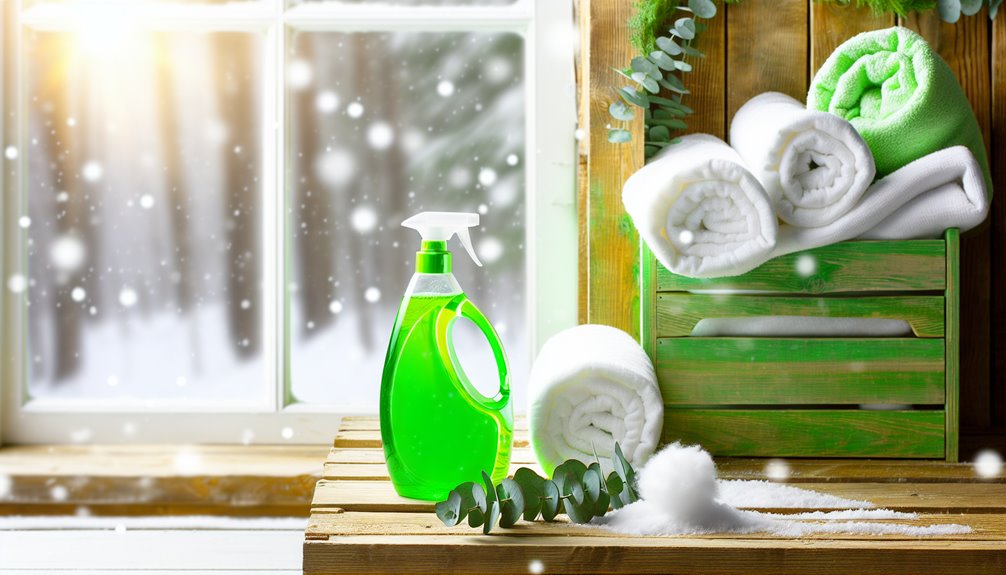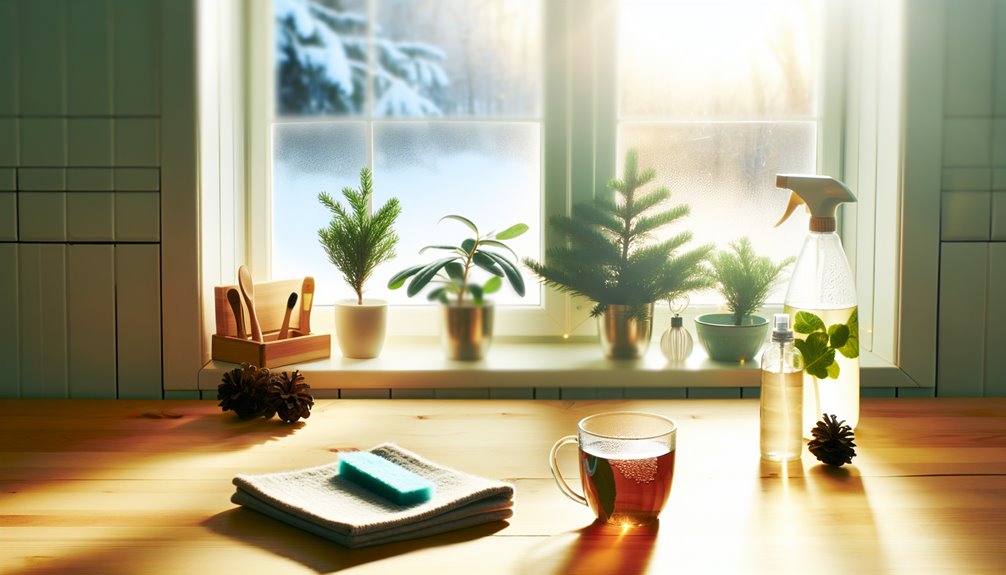
The Ultimate Guide to Green Cleaning During the Winter Months
Green cleaning during winter is key to a healthier home, and if you want professional assistance with eco-friendly practices, consider hiring clean maid services in 77387 to keep your space fresh and cozy. Using natural ingredients like vinegar, baking soda, or essential oils allows you to clean effectively without harsh chemicals that can harm your health or the environment. Sustainable tools, such as microfiber cloths and refillable spray bottles, minimize waste while enhancing your cleaning efforts.
Preventive practices play a vital role in maintaining a clean and healthy home. Check your HVAC systems regularly to ensure efficient air circulation and improved indoor air quality. Keep entryways clean to prevent dirt and allergens from spreading, and manage humidity levels to maintain comfort and reduce the risk of mold growth.
By adopting green cleaning practices and enlisting the help of clean maid services in 77387, you can create a clean, inviting atmosphere that feels good for both your family and the environment. Explore more tips and techniques to enhance your green cleaning routine and enjoy a healthier, cozier home this winter.
Key Takeaways
Utilize eco-friendly cleaning products like vinegar and baking soda to maintain a safe indoor environment free from harmful chemicals.
Implement preventive cleaning by using quality mats to reduce dirt and moisture entry during winter months.
Regularly clean high-touch surfaces and maintain HVAC systems to enhance indoor air quality and prevent respiratory issues.
Incorporate reusable cleaning tools, such as microfiber cloths, to minimize waste and effectively remove dirt and bacteria.
Create a cozy atmosphere with natural scents and indoor plants to improve air quality and promote a welcoming home environment.
Benefits of Green Cleaning
Green cleaning offers a multitude of benefits that can greatly enhance your health, environment, and budget. By choosing eco-friendly products, you reduce allergens and irritants in your home, leading to fewer allergic reactions and skin irritations. You'll also improve indoor air quality by eliminating volatile organic compounds and harsh chemicals, which can lower the risk of respiratory problems and long-term health concerns like liver and kidney failure.
From an environmental perspective, green cleaning minimizes pollution by using biodegradable and non-toxic products. This helps prevent harmful chemicals from entering our waterways and supports a circular economy through recycled packaging. Additionally, using eco-friendly products contributes to lower carbon emissions and promotes sustainable practices.
Economically, while eco-friendly products may have higher initial costs, they tend to last longer and require less frequent replenishment. This can save you money in the long run, as well as extend the life of your cleaning equipment and surfaces. Plus, a healthier workspace reduces employee absenteeism, boosting productivity.
Natural Ingredients for Cleaning

When you opt for natural ingredients in your cleaning routine, you're choosing effective solutions that benefit both your home and the environment. If you're looking for professional help to incorporate eco-friendly practices, consider hiring cleaning businesses near me to handle the work with care and expertise.
Baking soda is a versatile powerhouse for cleaning, deodorizing, and cutting through grease. Mix it with warm water and essential oils to create a fantastic solution for kitchen surfaces. For tougher jobs, combine baking soda with laundry soap and essential oils to make a soft scrub that’s perfect for tackling grime. Castile soap, made from 100% plant-based oils, is another excellent choice. It’s highly effective for cutting grease and sanitizing various surfaces. Mix it with water and essential oils to create a dusting spray or use it in an all-purpose cleaner for general cleaning tasks.
Vinegar is a natural go-to for eliminating soap scum and grime, thanks to its acidity. Use it in all-purpose cleaners or combine it with baking soda for a strong disinfectant solution. Additionally, vinegar helps avoid exposure to the harmful chemicals found in many conventional cleaners. Essential oils, like tea tree and lemon oil, enhance your cleaning solutions with natural disinfectant properties and pleasant scents. With these natural ingredients and the support of cleaning businesses near me, you can effectively clean your home while being kind to the planet, creating a safe and sustainable environment for
Eco-Friendly Cleaning Products
Choosing eco-friendly cleaning products not only helps keep your home spotless but also supports a healthier planet. When you opt for these products, look for certifications like Green Seal, ECOLOGO, and EPA Safer Choice. These labels guarantee that the ingredients are safer for you and the environment.
Many eco-friendly cleaners feature plant-based formulas that effectively cut through dirt without harsh chemicals. You'll find versatile, multi-surface options that work in kitchens, bathrooms, and beyond. Green Llama offers a range of products designed to promote a cleaner, greener world with every purchase. Plus, manufacturers often use eco-conscious packaging, like glass bottles and compostable containers, to minimize plastic waste.
By selecting products with low VOC content, you help improve your indoor air quality, creating a healthier living space. Brands such as Green Llama and Grove Collaborative offer powerful, non-toxic cleaning solutions, while Blueland and Branch Basics provide zero-waste options that further reduce environmental impact.
Using eco-friendly cleaning products not only shields your family from harmful substances but also supports companies committed to sustainable practices. With each purchase, you're contributing to a cleaner, greener future for everyone.
Sustainable Cleaning Tools

When it comes to sustainable cleaning tools, choosing eco-friendly materials makes a significant difference. You'll find that microfiber cloths aren't only efficient but also reusable, cutting down on waste. Additionally, incorporating bamboo brushes into your cleaning routine can further enhance your sustainability efforts.
Eco-Friendly Materials
Switching to eco-friendly materials for your cleaning routine not only benefits the environment but also enhances your cleaning efficiency. By opting for reusable cleaning tools, you can greatly reduce waste.
Consider using bamboo scrub brushes; they're durable and sustainable, perfect for tough scrubbing. Reusable mop pads can replace single-use heads, while cotton cloths are great for general cleaning and dusting. For a biodegradable option, cellulose cloths are compostable, and hemp cloths offer strength and eco-friendly properties.
When it comes to eco-friendly cleaning equipment, choose vacuum cleaners equipped with HEPA filters to effectively capture dust and allergens. Energy-efficient models cut down on power consumption, while rechargeable batteries help minimize waste. Moreover, selecting eco-friendly options can significantly reduce your individual carbon footprint and promote overall sustainability.
Look for vacuums made from recyclable materials and those with long-lasting filters to reduce replacement needs. Lastly, consider water conservation tools like buckets for cleaning, which prevent continuous water flow. Low-flow showerheads and faucets will help conserve water during your cleaning routine. With these eco-friendly materials, not only will you maintain a cleaner home, but you'll also contribute to a healthier planet. Make the switch and enjoy the benefits today!
Microfiber Efficiency
Microfiber's cleaning prowess makes it a top choice for sustainable cleaning tools, and if you're looking for expert cleaning help, consider hiring My House Cleaner to incorporate these eco-friendly solutions into your routine. Microfiber cloths are incredibly effective at removing microbial contamination from surfaces like stainless steel and ceramic tiles, significantly reducing harmful bacteria like MRSA and E. coli. This makes your cleaning routine both efficient and safer for your environment.
It's important to note, however, that microfiber cloths physically remove microbes but don't kill them without the aid of germicidal chemicals. Reusable microfiber cloths outperform disposable ones in both effectiveness and sustainability. To maximize their efficiency, launder your reusable cloths regularly. Interestingly, their performance often improves after about 75 washes, though it may decline after 150 washes. To maintain hygiene and prevent cross-contamination, always remove microfiber pads from frames before washing.
Microfiber aligns seamlessly with green cleaning practices by reducing the need for chemical cleaners, which can harm the environment. Additionally, many microfiber products are made from recycled materials, making them an even more sustainable choice. With the expertise of My House Cleaner, you can leverage these advantages to create a cleaner, healthier, and more eco-friendly home.
Reusable Options
Choosing reusable options for your cleaning routine not only enhances sustainability but also boosts effectiveness. Start with bamboo cleaning brushes, which are durable and come in various forms, including bottle and pot brushes. Their replaceable heads allow for extended use, and when they reach the end of their life, you can compost them.
Opt for compostable eco sponges made from biodegradable materials. These sponges are washable, suitable for non-stick pans, and come in multi-packs, greatly reducing plastic waste. Reusable Swedish sponge cloths can replace paper towels, as they're versatile, long-lasting, and effective on multiple surfaces.
Don't forget eco-friendly storage: refillable spray bottles let you store homemade cleaning solutions while cutting down on single-use plastics. Eco rubber gloves made from sustainable materials protect your hands during cleaning tasks and are durable enough for repeated use. Finally, consider sisal cleaning brushes for specific tasks; they're made with natural fibers and have replaceable heads for longevity.
Improving Indoor Air Quality

Improving indoor air quality during winter is essential for maintaining a healthy living environment. Start by ensuring your HVAC system runs efficiently. Change filters regularly to capture pollutants and enhance air quality. Clean filters not only improve efficiency but also reduce energy costs and prolong your system's lifespan. Schedule annual furnace maintenance to keep the heating system in top shape.
Next, enhance ventilation. Open windows occasionally to let fresh air in, even when it's cold outside. Use ceiling fans and exhaust fans in kitchens and bathrooms to boost airflow. Properly seal and clean ducts to prevent the circulation of dirty air.
Consider utilizing air purifiers equipped with HEPA filters to remove allergens and irritants. They're especially beneficial if you have allergies, asthma, or pets. Balancing humidity with humidifiers also helps alleviate dry skin and respiratory issues while preventing the spread of bacteria and viruses.
Finally, reduce indoor pollutants by limiting candles and harsh cleaning products. Opt for natural cleaners to minimize harmful fumes. Managing cooking-related exhaust and sealing sources of pollution, like asbestos, will further enhance your home's air quality this winter.
Preventive Cleaning Practices

Maintaining a clean environment goes hand in hand with improving indoor air quality, especially during winter when dirt and moisture can easily accumulate. Start by placing high-quality mats and rugs at every entrance to capture dirt, snow, and moisture from footwear. Properly sized mats can reduce up to 80% of soil entering your space, so make sure to regularly clean and replace them as needed. Microfiber mats are especially effective at trapping soil and reducing airborne particles.
Next, focus on high-touch surfaces like door handles, light switches, and countertops. Clean these areas frequently, using EPA-approved disinfectants to eliminate germs. Aim to clean multiple times a day during high foot traffic, especially if someone is sick. For best results, use the "Spray and Wipe" method for controlled application.
Don't forget about your HVAC system! Replace air filters every winter and consider professional cleaning of ducts and vents to improve efficiency. Proper ventilation helps control moisture and prevent mold growth. Finally, perform deep cleaning on floors and surfaces to protect against winter damage while minimizing the spread of soil throughout your space.
Eco-Friendly Fabric Care

When it comes to eco-friendly fabric care, you can start by mastering hand washing techniques that save water and energy. You'll also want to explore energy-saving drying methods to cut down on your laundry's carbon footprint. Finally, proper storage solutions can help maintain your fabrics' quality and extend their lifespan.
Hand Washing Techniques
In winter, keeping your fabrics clean and fresh can be a challenge, but eco-friendly hand washing techniques make it easier. Start by choosing hand soaps with certifications like UL 2784 or Green Seal GS-41, guaranteeing they're safe for both you and the environment. Look for biodegradable and recyclable packaging to further reduce your impact.
Opt for hand soaps that boast a high percentage of biobased ingredients, as recognized by the USDA BioPreferred program. It's also wise to select mild soaps with a balanced pH, as they're gentle on your skin, preventing dryness even during frequent use. Avoid antibacterial soaps unless absolutely necessary; regular hand soaps are often sufficient.
Use products featuring Clean Release Technology to save water while rinsing effectively. Consider concentrated formulations to minimize packaging waste and guarantee you get more value. Finally, promote the use of sealed soap dispensing systems to prevent contamination and support hygiene.
Energy-Saving Drying Methods
Hand washing techniques may help you keep your fabrics clean, but energy-saving drying methods can further enhance your eco-friendly fabric care routine during winter.
Start by using cold or low heat settings in your dryer; this can reduce energy use by over half. After your drying cycle, utilize the cool-down cycle to let clothes finish drying with residual heat, saving energy. Remember to clean the lint filter after each use to improve air circulation and prevent fire hazards. A well-maintained dryer vent is essential, too; verify it's not blocked to maximize efficiency.
If your dryer has moisture sensors, use them they automatically shut off when clothes are dry, preventing over-drying. Consider air-drying your clothes on drying racks or lines, especially for delicate fabrics. It's energy-efficient and often recommended by manufacturers.
When using the dryer, separate heavier loads like towels from lighter items for more efficient drying. If you're in the market for a new dryer, look into high-efficiency models, like heat pump dryers, which can reduce energy use by nearly 30%. These methods not only save energy but also prolong the life of your fabrics.
Proper Storage Solutions
How can you guarantee your fabrics stay in top condition during winter storage? Start by laundering all your clothing before putting them away. Use gentle, fragrance-free detergents or baking soda to avoid attracting moths and pests. Remember, strong fragrances can damage fabrics over time, so stick to eco-friendly, biodegradable options. Wash in colder water on shorter cycles to conserve energy and minimize wear.
Next, choose the right storage materials. Opt for organic cotton storage cubes or cloth garment bags for your most valued pieces. Airtight bins are great for keeping clothes fresh and secure. Make sure these materials are machine washable, durable, and made from earth-friendly practices.
When organizing, fold or hang items according to their fabric type. For natural fibers like wool and silk, handle with care, while rolling less bulky items like t-shirts is a smart move. Always leave enough space in your containers to prevent overstuffing.
Finally, store your fabrics in a climate-controlled area, avoiding attics or garages prone to moisture. Use breathable bags or bins to guarantee air circulation, and keep your storage area free from dust to protect your cherished fabrics.
Tips for Winter Maintenance

Winter maintenance is essential for keeping your home safe and efficient during the colder months. Start by cleaning your gutters to prevent ice dams and protect your foundation. Inspect your roof for damage and algae, and soft wash the shingles if needed. Prune any overhanging branches to prevent ice damage.
Inside, find and repair drafts around doors and windows to save on heating costs. Test your sump pump by pouring water into it to verify it's functioning properly. Don't forget to reverse your ceiling fans to push warm air down, creating a cozier atmosphere.
For your yard, give it a final trim, clean out flower beds, and rake leaves before the frost hits. Winterize your garden to protect plants from freezing temperatures. Additionally, clean out your irrigation system to prevent damage from freezing water.
Finally, tackle seasonal deep-cleaning by washing windows and curtains, deep cleaning your kitchen and bathroom, and organizing your entryway. Dust and vacuum your living room, and give attention to baseboards and vents to improve indoor air quality.
Follow these tips to keep your home warm and welcoming all winter long!
Frequently Asked Questions
How Can I Effectively Remove Mold in Winter Using Green Methods?
To effectively remove mold in winter, use vinegar or hydrogen peroxide. Guarantee proper ventilation, control humidity, and apply solutions directly onto affected areas. Remember to wear protective gear while scrubbing and rinsing thoroughly afterward.
What Are the Best Natural Air Fresheners for Winter Months?
You can create natural air fresheners for winter by using simmer pots with citrus and spices, essential oil diffusers, DIY sachets, or eco-friendly sprays. These options provide cozy scents without harmful chemicals, keeping your home inviting.
Can I Use Vinegar on All Types of Surfaces?
No, you can't use vinegar on all surfaces. It's great for glass and ceramic but can damage unfinished wood, natural stone, and electronics. Always test on a small area before applying it widely.
How Do I Maintain My Cleaning Tools During Winter?
To maintain your cleaning tools during winter, clean them after each use, store them in a dry, ventilated area, and apply protective coatings to metal parts. Regular inspections help catch any damage early, too.
Are There Eco-Friendly Options for Ice Melt on Sidewalks?
Yes, you've got eco-friendly options for ice melt on sidewalks. Consider calcium magnesium acetate, alfalfa meal, or modified urea. These alternatives are safe for pets and plants while effectively managing ice without harming the environment.
Conclusion
By embracing green cleaning this winter, you're not just protecting the planet; you're also creating a healthier home for yourself and your family. With natural ingredients, eco-friendly products, and sustainable tools, you can tackle grime without harmful chemicals. Remember to focus on indoor air quality and preventive practices to maintain a fresh environment. So, as you cozy up during the colder months, make green cleaning a priority and enjoy a cleaner, greener space all season long!